When it comes to maximizing your efforts in the gym (and consequently your results), a little bonus knowledge goes a long way. Although the “best exercises” for a particular muscle group are quite subjective, considering each individual responds to a particular stimulus differently, over time certain exercises came to dominate due to their overall effectiveness (on average). Nonetheless, due to the overwhelming amount of variation among the exercises available to stimulate a particular muscle, helpful data on what may be of benefit over something else is not concrete wisdom but can certainly enhance training. Which is why the following study can be taken with a grain of salt, but certainly provide valuable information at the same time.
For an exercise to be efficient at its objective of helping you grow muscle, it must effectively stimulate that muscle and cause it to fatigue. Therefore, different levels of stimulation among different exercises can help gauge which exercise is worth more than another. However, that same worth can be altered by tweaking a particular exercise (which will change the amount of stimulation it produces). This is partly why the study below is only a rough indicator. To illustrate this further, someone doing incline dumbbell press (for chest) at a different incline degree than another individual may witness significant (noticeable, at the very least) differences in stimulation. Since the study does not account for these matters, we have to keep that in mind.
On a similar note, the “best exercises” for a particular muscle group can be completely altered when you factor in the Mind Muscle Connection. An individual who is performing bench press but puts more stress on his shoulders and triceps than on his chest will stimulate the chest to a different degree than someone performing the same exercise with a focus on moving the weight solely with the chest (minimizing the other muscles as much as possible). The participants in the study could have all been engaging in the MMC, or could have simply been attempting to push the weight, a drastic difference that is not accounted for.
Lastly, and perhaps most importantly, the accuracy of measuring the amount of stimulation through an EMG study depends on several factors. The competence of the administrators, the placement of the sensors on each muscle (putting a sensor on the inside of your chest and on the outside will certainly make a difference), and quality of the materials used (among others).
Pectoralis major:
Decline dumbbell bench press – 93
Decline bench press (Olympic bar) – 89
Push-ups between benches – 88
Flat dumbbell bench press – 87
Flat bench press (Olympic bar) – 85
Flat dumbbell flys – 84
Pectoralis minor:
Incline dumbbell bench press – 91
Incline bench press (Olympic bar) – 85
Incline dumbbell flys – 83
Incline bench press (Smith machine) – 81
Medial deltoids:
Incline dumbbell side laterals – 66
Standing dumbbell side laterals – 63
Seated dumbbell side laterals – 62
Cable side laterals – 47
Posterior deltoids:
Standing dumbbell bent laterals – 85
Seated dumbbell bent laterals – 83
Standing cable bent laterals – 77
Anterior deltoids:
Seated front dumbbell press – 79
Standing front dumbbell raises – 73
Seated front barbell press – 61
Biceps:
Biceps preacher curls (Olympic bar) – 90
Incline seated dumbbell curls (alternate) – 88
Standing biceps curls (Olympic bar/narrow grip) – 86
Standing dumbbell curls (alternate) – 84
Concentration dumbbell curls – 80
Standing biceps curls (Olympic bar/wide grip) – 63
Standing E-Z biceps curls (wide grip) – 61
Triceps:
Decline triceps extensions (Olympic bar) – 92
Triceps pressdowns (angled bar) – 90
Triceps dip between benches – 87
One-arm cable triceps extensions (reverse grip) – 85
Overhead rope triceps extensions – 84
Seated one-arm dumbbell triceps extensions (neutral grip) – 82
Close-grip bench press (Olympic bar) – 72
Latissimus dorsi:
Bent-over barbell rows – 93
One-arm dumbbell rows – 91
T-bar rows – 89
Lat pulldowns to the front – 86
Seated pulley rows – 83
Quadriceps:
Squats (parallel depth, shoulder-width stance) – 88
Seated leg extensions (toes straight) – 86
Hack Squats (90 degree angle, shoulder-width stance) – 78
Leg press (110 degree angle) – 76
Smith machine squats (90 degree angle, shoulder-width stance) – 60
Hamstrings:
Seated leg curls – 88
Standing leg curls – 79
Lying leg curls – 70
Stiff Legged Deadlifts – 63
Calves:
Donkey calf raises – 80
Standing one-leg calf raises – 79
Standing two-leg calf raises – 68
Seated calf raises – 61
Some of these, to the advanced lifter, may seem a little unbelievable. For example, tricep exercises such as the pressdown having a higher value than a close grip bench press. Keep in mind here that a close grip bench press is a compound movement that involves many more muscles while a pressdown is a tricep isolation movement. Between all those other muscles being activated during a CGBP it is understandable that the value is lower, but at the same time the amount of weight used is probably much greater (therefore, more overload and possible growth). This is another reason why the study can’t be taken to be some holy grail of determining the best exercises. Nonetheless, it is a good indicator of what works and if you use your Mind-Muscle Connection and really use those exercises to the best of your ability (by trying to isolate the targeted muscle and making it do as much of the movement as possible), the above study can become the icing on the cake. For more on maximizing your results, check out our Gain Muscle article. Good luck!
Incoming search terms:
- emg triceps

![Best Exercises for Different Muscle Groups [EMG Data]](http://fitnfly.com/wp-content/uploads/2011/05/Best-Exercises.jpg)
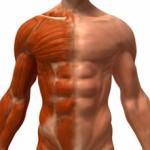
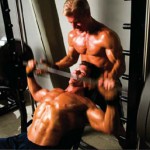
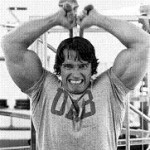
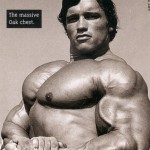
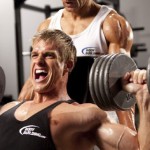

I’ve been looking for this type of information for my research. Thanks